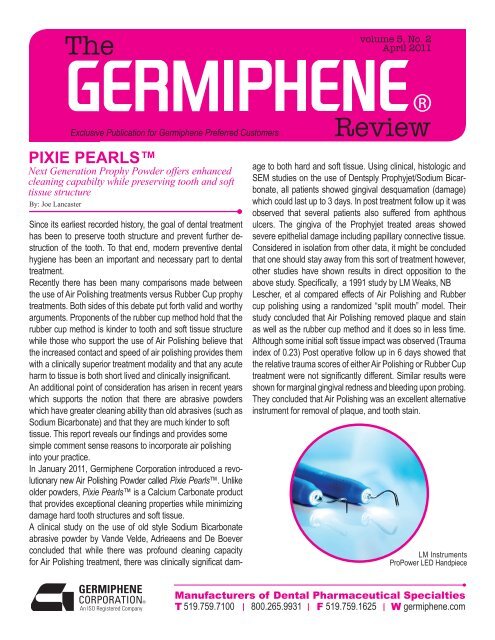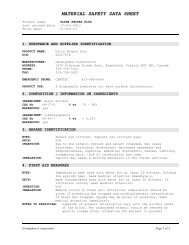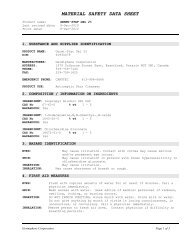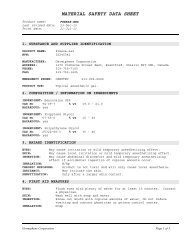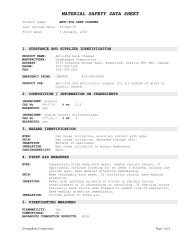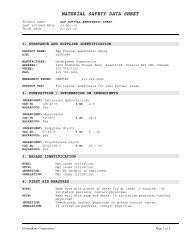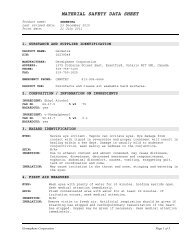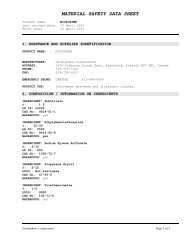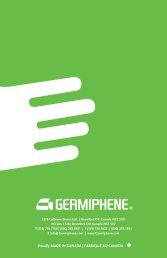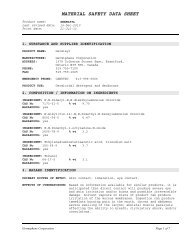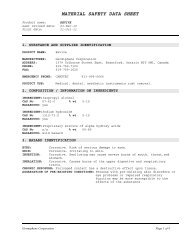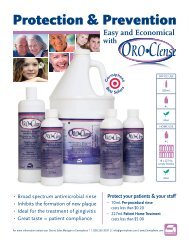Pixie Pearls - Germiphene
Pixie Pearls - Germiphene
Pixie Pearls - Germiphene
Create successful ePaper yourself
Turn your PDF publications into a flip-book with our unique Google optimized e-Paper software.
Thevolume 5, No. 2April 2011Exclusive Publication for <strong>Germiphene</strong> Preferred CustomersPIXIE PEARLSNext Generation Prophy Powder offers enhancedcleaning capabilty while preserving tooth and softtissue structureBy: Joe LancasterReviewSince its earliest recorded history, the goal of dental treatmenthas been to preserve tooth structure and prevent further destructionof the tooth. To that end, modern preventive dentalhygiene has been an important and necessary part to dentaltreatment.Recently there has been many comparisons made betweenthe use of Air Polishing treatments versus Rubber Cup prophytreatments. Both sides of this debate put forth valid and worthyarguments. Proponents of the rubber cup method hold that therubber cup method is kinder to tooth and soft tissue structurewhile those who support the use of Air Polishing believe thatthe increased contact and speed of air polishing provides themwith a clinically superior treatment modality and that any acuteharm to tissue is both short lived and clinically insignificant.An additional point of consideration has arisen in recent yearswhich supports the notion that there are abrasive powderswhich have greater cleaning ability than old abrasives (such asSodium Bicarbonate) and that they are much kinder to softtissue. This report reveals our findings and provides somesimple comment sense reasons to incorporate air polishinginto your practice.In January 2011, <strong>Germiphene</strong> Corporation introduced a revolutionarynew Air Polishing Powder called <strong>Pixie</strong> <strong>Pearls</strong>. Unlikeolder powders, <strong>Pixie</strong> <strong>Pearls</strong> is a Calcium Carbonate productthat provides exceptional cleaning properties while minimizingdamage hard tooth structures and soft tissue.A clinical study on the use of old style Sodium Bicarbonateabrasive powder by Vande Velde, Adrieaens and De Boeverconcluded that while there was profound cleaning capacityfor Air Polishing treatment, there was clinically significat damageto both hard and soft tissue. Using clinical, histologic andSEM studies on the use of Dentsply Prophyjet/Sodium Bicarbonate,all patients showed gingival desquamation (damage)which could last up to 3 days. In post treatment follow up it wasobserved that several patients also suffered from aphthousulcers. The gingiva of the Prophyjet treated areas showedsevere epithelial damage including papillary connective tissue.Considered in isolation from other data, it might be concludedthat one should stay away from this sort of treatment however,other studies have shown results in direct opposition to theabove study. Specifically, a 1991 study by LM Weaks, NBLescher, et al compared effects of Air Polishing and Rubbercup polishing using a randomized “split mouth” model. Theirstudy concluded that Air Polishing removed plaque and stainas well as the rubber cup method and it does so in less time.Although some initial soft tissue impact was observed (Traumaindex of 0.23) Post operative follow up in 6 days showed thatthe relative trauma scores of either Air Polishing or Rubber Cuptreatment were not significantly different. Similar results wereshown for marginal gingival redness and bleeding upon probing.They concluded that Air Polishing was an excellent alternativeinstrument for removal of plaque, and tooth stain.LM InstrumentsProPower LED HandpieceManufacturers of Dental Pharmaceutical SpecialtiesT 519.759.7100 800.265.9931 F 519.759.1625 W germiphene.com
Is there a point where speed and efficacy of air polishingtreatment can override clinically insignificant soft tissue impact– and provide superior treatment outcomes? Is there a cleaningpowder that can provide superior results with little or no traumato hard and soft tissue?With the introduction of <strong>Pixie</strong> <strong>Pearls</strong> Calcium CarbonateProphy powder, dental professionals may now safely utilize AirPolishing as an effective and minimally invasive solution to theremoval of tooth stain and plaque. Utilizing next generation LMInstruments Air Prophy/Scaling equipment, studies were performedusing two separate Sodium Bicarbonate based Prophy Powders andone Calcium Carbonate powder. The Sodium Bicarbonate particulatewas of random shape and size and charcterized bysome sharp edges and some wide flat sides. <strong>Pixie</strong> <strong>Pearls</strong>Calcium Carbonate powder was of spherical shape withoutsharp protrusions or flat surface areas.After exposing sample teeth and temporary metal crowns toboth the Sodium Bicarbonate and Calcium Carbonate powder,for equal times and at equal distances it was clearly evident thatthe <strong>Pixie</strong> <strong>Pearls</strong> Calcium Carbonate powder cleaned significantlybetter than the Sodium Bicarbonate powder. Of greatersignificance from a clinical standpoint was the fact that the CalciumCarbonate did not damage hard tooth structure, whereassevere abrasion was observed with both of theSodium Bicarbonate powders.<strong>Pixie</strong> <strong>Pearls</strong> exhibit greater cleaning action than old styleSodium Bicarbonate Powders because all sides of each particleare able to clean, whereas only the sharp sides of the SodiumBicarbonate particle provide optimal cleaning activity. Flattersides are unable to remove stain but contribute to the quantityof superfluous slurry that must be managed with large quantitiesof water. Since the <strong>Pixie</strong> <strong>Pearls</strong> particulate can clean on allsurfaces, the amount of water required to manage the resultantslurry may be reduced making it easier to manage for both theDental Professional and the patient.Additional Considerations:Older style Prophy Powders are notoriously associated withclogging of equipment which unnecessarily delays treatment.This is frustrating to both the patient and the dental care provider.Jamming of prophy jet nozzles is the inevitable result ofhumidity or moisture contacting Sodium Bicarbonate. Becausethere are numerous flat surfaces to Sodium Bicarbonate particles,even minute amounts of water tend to bind the particlestogether in much the same way as a brick wall or cobblestonestreet are formed. The resultant blockage can be difficult toclear and can sometimes result in damage to equipment oreven cause “sharps” injuries to the Dental professional as theytry to clear the blockage. The spherical particulate of <strong>Pixie</strong><strong>Pearls</strong> Calcium Carbonate powder has significantly less contactarea between particles allowing less area for moisture tocreate a bond between particles. The resultant powers is less aptto jam nozzles, foul internal lines or lead to down time of the unit –sometimes for extended periods of time due to expensive servicing.With the advent of Calcium Carbonate Prophy powders such as<strong>Pixie</strong> <strong>Pearls</strong> and “next generation” delivery systems such asthe LM ProPower Air Prophy/Power Scaler, Dental Professionalsnow have the products and delivery systems available to affectsuperior dental hygiene and perio treatments in a timely andcost effective manner. With the use of these products, treatmentis improved by reducing damaged to hard and soft tissue,minimizing the amount of slurry required to affect treatmentand by virtually eliminating down time due to equipment failure.LM InstrumentsProPower AirLED!!PROPHYflex Sodium Bicarbonate! !GERMIPHENE (Calcium Carbonate)Manufacturers of Dental Pharmaceutical SpecialtiesT 519.759.7100 800.265.9931 F 519.759.1625 W germiphene.com


